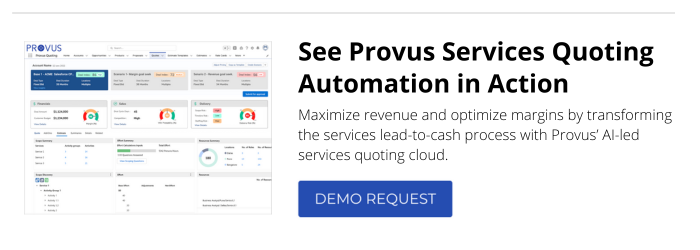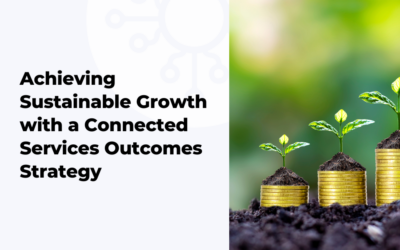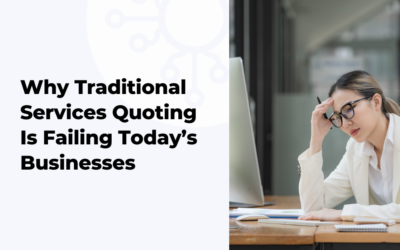Automation has long been recognized for its potential to increase productivity. Traditionally, this meant identifying repetitive tasks, or those requiring high manual labor. The type of scenarios that work for product-based processes and quoting, with fixed quantities, assets, and bundles.
However, things are different for services quoting, where greater flexibility and customization is needed for winning the deals and delivering the types of results customers expect. Here’s where finding the gains and margins call for a fluid mix of automation and AI capabilities.
That’s because combining AI capabilities with process automation in your quoting process will drive the next phase of growth within your organization. Toward a reality where information isn’t just being ingested and left waiting to be crunched by a data scientist. Instead, by connecting actual services data and adding AI into the front of your services revenue lifecycle, this allows true top and bottom line revenue growth.
These capabilities go beyond finding efficiencies through automation, toward a total platform driving four key outcomes of the business.
Revenue Growth
An automated historical data flow helps build a more comprehensive customer view. Naturally, a greater understanding of behaviors and patterns can be used to identify potential upsell and cross-sell opportunities. The deal size can be further increased by the AI flagging any missing elements to be added, using insights extracted from previous projects.
With the increased visibility of historical actions comes greater potential for business insights. For example, AI-assisted root-cause analysis to examine work breakdowns, solve revenue leakage, and identity potential growth areas.
The AI can also analyze higher data volumes at greater speeds, giving reps the ability to quickly model and compare complex what-if scenarios. There’s increased objectivity, meaning less reliance on assumptions and other human-led biases that can impact revenue forecasting.
Over time the AI brings automated learning to the services CPQ table, helping to continuously refine and improve projection outputs. Ultimately, the blend of AI brings a form of guided selling for even the most complex of offerings.
Services Profitability
Variables that can drive down services margins during a project are vast. Clear visibility into impacts on margins is needed for building quotes. Especially when selling services that may be extremely complex, requiring configuration and customization. Oftentimes with dynamic, discounted, and recurring pricing models.
After all, sales reps know the savings from customer retention vs. acquisition. And in today’s As-A-Service era, Customer Lifetime Value is a key metric that can optimize margins, simply by ensuring project delivery matches the customer’s expectations during quoting, scoping, and renewing.
That calls for historical data to be automatically collected and provided to the AI. Then the technology can help to quickly identify margin optimization opportunities throughout the project scope. This gives visibility of data to support predictive approaches, something that locally stored spreadsheets and bolted-together systems can’t provide.
Reps also need quoting support to safeguard margins against unforeseen macro-economic changes downstream, from supply chain issues to inflation. These impact resource forecasting, and can easily lead to underused resources when bottlenecks appear. And then having to ramp up extra resources – and costs – to offset the resulting delays and ensure delivery for the customer.
Operational Efficiency
Manually preparing quotes is laborious, the admin, data entry, chasing up information from different departments. That’s before the initial offer comes back with requests to modify quotes. These are often compounded by inputs from more stakeholders as the quote progresses.
The more manual intervention needed, the greater the potential for delaying sales cycles, pricing errors or inconsistencies to creep in, potentially impacting operations, along with revenue, margins, and compliance. It’s no wonder that sales reps reportedly spend ’just 28% of their week actually selling.’
Instead, you can find competitive advantage by configuring an AI rules-based engine. It’s a systemic approach that allows for greater consistency, standardization, and scalability. There’s greater visibility at each stage of the cycle, allowing successful frameworks to be shared and adapted.
This helps shorten sales cycles and proposal turnaround time, and allows reps to keep momentum high and respond faster when prospects and customers ask for revisions to quotes or catalogs. Templates can be created, updated, and stored centrally and automatically.
What’s more, the increased efficiency frees up reps for the work that automation and AI can’t do. All those customer experience and nurturing workflows that build up business relationships and rely on empathy and understanding.
Compliance
Early forms of automation were about optimizing workflows, assigning tasks and mapping escalations.
Incorporating AI and the ability to learn from historical data now means reps can do more discovery, and model and predict using contextual analysis. Any change, for example to corporate T&Cs after a regulatory update, can be rolled out to the master version, instead of chasing departments to update locally.
It’s a win-win scenario. Customers and prospects get answers faster, and with greater accuracy and granularity. Reps can quote with confidence, with more control over catalog configurations.
The overall business can bring greater consistency and efficiency to quoting, greater flexibility, and greater security by ensuring only the latest documents are being used.
Automation and AI: Laying Foundations for Business Growth
Applying AI and automation to any of these four key areas has a compound effect on top and bottom line growth. Maximizing revenue means all gaps are covered. Boosting margins improves the sales cycle, magnifying savings from operational efficiencies allowing more growth-focused investment.
And with the evolving nature of compliance, especially around data privacy and usage, it’s ever more important to mitigate risks from manual updates through harnessing automation. These interdependencies mean that optimizing upstream helps boost improvements further downstream.
That’s why services organizations need a system that allows the data – scoping, estimation, pricing – to flow freely into CRM. So that it can be automatically enriched and used strategically with AI for services quoting. And allow businesses to permanently progress beyond static spreadsheets and fixed formulas.









